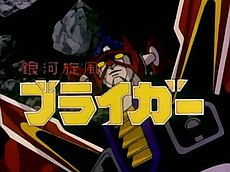Braiger
| Galaxy Cyclone Braiger | |

Screenshot of the series' logo
|
|
|
銀河旋風ブライガー (Ginga Senpuu Braiger) |
|
|---|---|
| Genre | Mecha |
| Anime television series | |
| Directed by | Takao Yotsuji |
| Produced by | Shigeo Tsubota and Tokichi Aoki |
| Music by | Isao Taira |
| Studio | Kokusai Eiga-sha |
| Network | TV Tokyo |
| Original run | October 6, 1981 – June 25, 1982 |
| Episodes | 39 |
Galaxy Cyclone Braiger (銀河旋風ブライガー Ginga Senpū Buraigā?) is an anime series aired from 1981 to 1982 in Japan. There were 39 episodes aired. Other loosely translated names include "Braiger", "Bryger", "Brygar", "Galactic Whirlwind Bryger", "Galactic Cyclone Buraiger", "Cosmo Runner". It is the first series from the J9 Series, which would be continued in Baxingar and Sasuraiger.
In the year 2111, the solar system has been colonised with various criminal organisations running amok. Team Cosmoranger J9 is assembled with Isaac Godonov, Blaster Kid, Steven Bowie, and Angel Omachi fighting the underworld scourge throughout the solar system. With the robot Braiger, they are a mercenary team that will handle any missions the police will not handle. Meanwhile, Earth has been divided into the four Connections of Omega, Red Dragon, Volga and Nubia while the other celestial bodies are divided into the five Connections of Galico (Jupiter), Viking (Mars), Venus, Uranus, and the Weapons Guild (Mercury). Through Khamen Khamen, Nubia hatches a plan to rule the solar system in which Jupiter is destroyed, leading to the creation of over 30 smaller planets that could sustain life. However, such a plan would lead to the destruction of Earth's inhabitants.
Braiger is primarily a flying car referred to in the series as Brai-Thunder that can activate synchron energy to grow in size for up to twenty four hours by transporting matter from another universe onto itself. Upon doing this the Brai-Thunder can transform into its shuttle form, Brai-Star. If needed the synchron energy can be charged up to maximum capacity, allowing the Brai-Star to transform into Braiger.
The series was supposedly inspired by real-life scientific research and used a lot of Korean talents at the lower ranks of production. The Braiger illustrator (Kazuo Komatsubara) was asked to create characters that looked like those in Lupin III. The music in the series is also heavily influenced by rock and roll although the ending theme has more in common with blues.
...
Wikipedia
